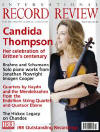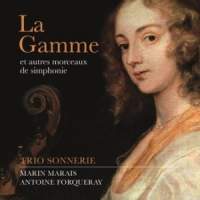Texte paru dans: / Appeared in:
*

International Record Review - (04/2013)
Pour
s'abonner / Subscription information
Linn CKD434

Code-barres / Barcode : 0691062043427
For many collectors Linn is rapidly establishing itself as the label of choice for Early Music. With several outstanding period instrument ensembles on its books and sensitively engineered recordings, often made in unusual locations (this one, for example, was recorded in the picturesque parish church at Dalton-in-Furness at the extreme north western tip of England), what distinguishes many of Linn’s Early Music recordings is the repertoire, driven, it would seem, by the enthusiasms of the musicians themselves rather than some commercially conscious A & R department. This latest release is a classic example.
Taking as a starting point a planned monument, designed at impossible cost in the early. eighteenth century by Titon du Tillet, and subsequently reduced to a substantial book — Le Parnasse Français — documenting the great poets and musicians of the reign of Louis XIV, Trio Sonnerie explores music by two Frençh composers from the start of the eighteenth century. While Lully was the pre-eminent composer in Titon du Tillet’s view, there were several lesser figures including Saint-Colombe, Louis Couperin, De Lalande, Bernier and Marin Marais. This disc concentrates primarily on the music of Marais and, in particular, the three pieces he published in 1723 as La Gamme et autres morceaux de simphonie pour le violon, la viole et le clavecin.
The principal piece in that publication is the extraordinary La Gamme en forme de petit Opéra a continuous work of some 40 minutes which explores with increasingly labyrinthine harmonic twists and turns an ascending and then descending scale. Each of the three instruments is given moments of great virtuosity and there are numerous passages of dialogue and genuine trio which find these musicians clearly at ease with each other, bending to the music’s continually evolving rhythmic design as it moves seamlessly between the dances of a typical French suite and more Germanic forms such as the fugue. Despite the music’s continuous flow, the disc has subdivided it into sections more clearly evident on the printed page than to the ear, and while James Johnstone in his interesting (if not entirely illuminating) booklet notes suggests this stems from Marais’s own advice to do this ‘so as not to bore the listener ‘, with playing of such vitality and colour as we have here, boredom is the last sensation anyone is likely to experience.
The two other Marais works from the 1723 publication are no less intriguing, if considerably shorter in overall length. The Sonate à la Marésienne is also in one continuous movement but comprises sections equivalent to the dances of a Baroque suite. Notable here is the robust gamba playing of Emilia Benjamin whose diversions down to the bottom of her instrument, percussive chords and flights into the upper register are given ample space by delightfully poised accompanying from Johnstone. Sonnerie de Sainte Geneviève du Mont de Paris is built on three endlessly repeated notes in the bass, above which Monica Huggett expounds delicately dancing ideas, full of echo effects and decorative asides.
Sandwiched between all this Marais are six character pieces by Antoine Forqueray. Not mentioned in Le Parnasse Français Forqueray earns his place on this disc by being, in Johnstone’s words, a rival to Marais and one ‘who now laid ‘claim to his crown’ . These are six extraordinary display pieces, primarily for viola da gamba (although in ‘La Portugaise’ Johnstone gleefully accepts the challenge of powerfully robust piece for solo harpsichord). The egotistically entitled ‘La Forqueray’ is quite the most alarming of the six pieces, making use of a harmonic palette, which, even to twenty-first century ears, seems distinctly adventurous.
Clearly these three musicians are relishing this
opportunity to indulge in repertoire which, in the normal course of events,
might not warrant too much attention outside a tight circle of French
Baroque fanatics. It is both a privilege and utter pleasure to share in not
only truly lovely music-making but also such intriguing and eminently
worthwhile music.
Fermer la fenêtre/Close window
Cliquez l'un ou l'autre
bouton pour découvrir bien d'autres critiques de CD
Click either button for many other reviews


